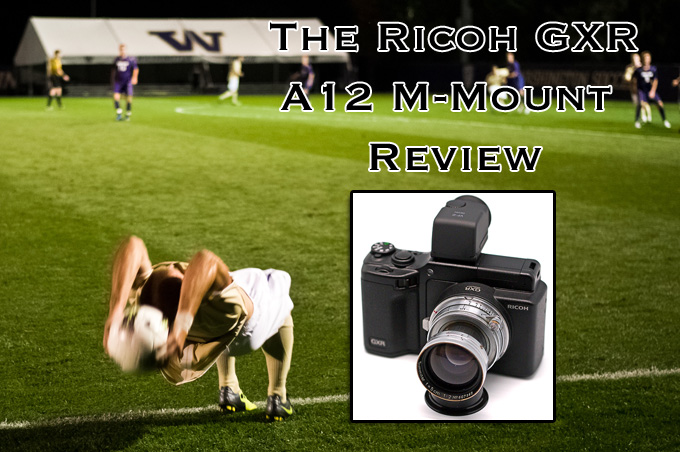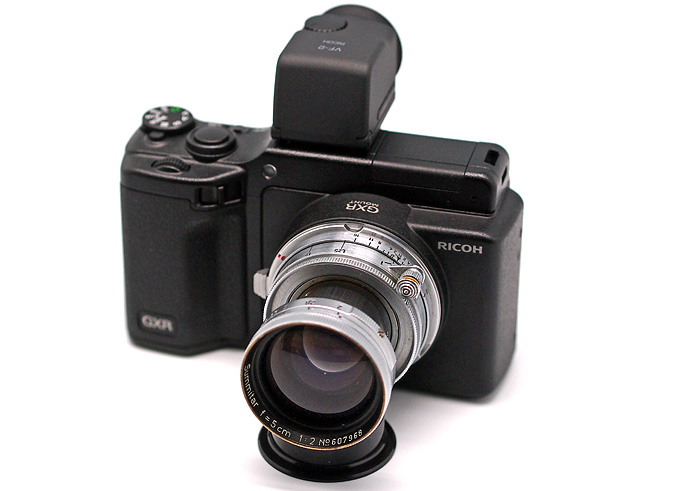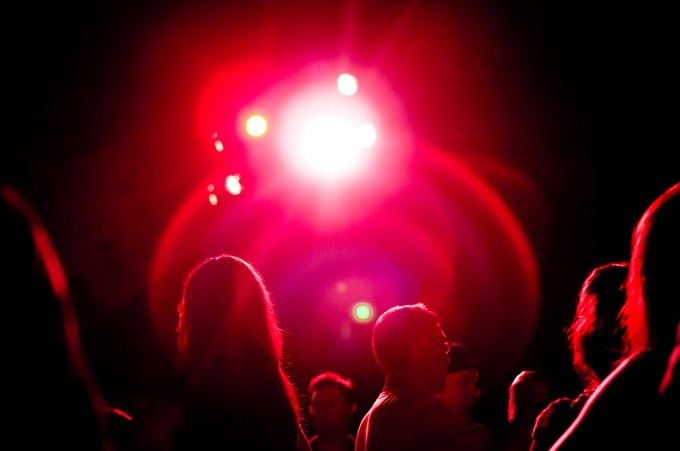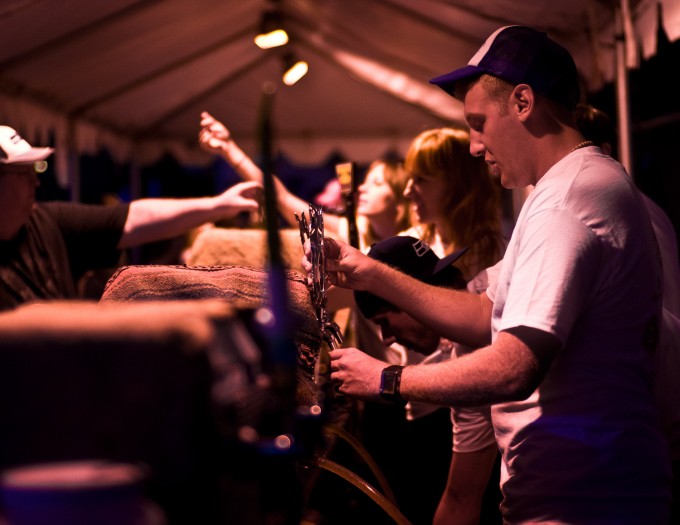
The Ricoh GXR A12 M-Mount Review – The Digital CL Reborn?
By Ashwin Rao
Visit Ashwins blog HERE – His Flickr HERE – Steves GXR Review HERE
Hi, friends and fellow photographers, today I am bringing to you my real world perspectives on the new Ricoh GXR A12 M-Mount module. For those of you who are not yet aware, Ricoh has been pumping out fantastic compact cameras for several decades now, and their compact line of GRD cameras stands at the forefront of compact cameras designed specifically with photographers in mind. As many of you already know, Ricoh entered the large sensor compact fray nearly 2 years ago with the introduction of the Ricoh GXR. Unlike it’s other compact large-sensor brethren,
Ricoh took a novel design approach of building lens-sensor combos, essentially coupling lenses to a specific sensor tailored to that lenses needs. The GXR modules came in 2 flavors, the A12 modules, which utilize a 1.5x crop APS-C size sensor similar in size to those used in Sony and Nikon SLR cameras, and the P10&S10 modules, which use a much smaller sensor similar to those found in most compact pocket cameras today. Steve reviewed the wonderful 28 mm and 50 mm equivalent A12 modules earlier this year and came away favorably impressed. Despite their best efforts to market the GXR as a versatile compact camera option to compete with the NEX cameras and micro 4/3’s cameras, the GXR has remained a niche product aimed at photographers who appreciate customization and image quality first.
All of that being said, Ricoh recently piqued the curiosity of many Leica M shooters by announcing a new A12 module with a native M mount and a 1.5 crop sensor capable of accepting nearly all Leica M mount lenses ever made. They priced this module at $649, same as the other A12 modules, and reported that the M mount module would also incorporate micro lenses and several other corrective measures to limit vignetting of wide angle lenses mounted on this module. Further, Ricoh reported that the M-mount A12 module would NOT incorporate an anti-Aliasing (blur) filter….
So, has Ricoh provided photographers with one of the holy grails of photography, a Digital CL equivalent camera, capable of using M mount lenses in a compact package? Read on to find out 😉
Under Red Lights – GXR at night – Oktoberfest –
CLICK IMAGES IN THIE REVIEW FOR LARGER AND BETTER VERSIONS!
St. Pauli Girls
A Word on the Anti-Aliasing Filter
To me, that last statement was BIG news….huge news, really. Finally, a company other than Leica was taking the step of removing the anti-aliasing filter from its sensor, thus, in theory allowing mounted lenses to achieve their maximal resolution on a 1.5 crop sensor. Other than the Leica M8, with its 1.3x sensor, the Leica M9 with its full frame sensor, and medium format cameras that are out of reach for most of us, no camera manufacturer had taken the bold step to exclude this anti-aliasing filter from their camera’s sensor. The argument behind anti-aliasing filters, for those of you who don’t know, is that they limit moiré patterns, which cause odd banding effects in images where repetitive patterns are captured. Moiré results when a lens out-resolves its sensor and creates aberrations, and the phenomenon is unique to digital photography (to the best of my knowledge), and so several years ago, the big 2 (Canon & Nikon) decided to incorporate anti-aliasing (AA) filters to eliminate the risk of moiré effects in images coming from their cameras. Unfortunately, using AA filters comes at a cost: loss of resolution, specifically at the pixel-peeping/micro-contrast level….Have you ever zoomed in on an image taken with your Nikon/Canon/Sony/etc dSLR and observed that images have that “Waxy” look to them? Therein is the unintended side effect of AA filters… Have you noticed that your M8 and M9 files do not seem to have this waxy look? What you are seeing is Leica’s decision to exclude the AA filters from their CCD sensors…
Some have argued that incorporating AA filters causes a blur effect and effectively cancels out some of the unique properties of the lenses to which the sensor is coupled? I know many photographers out there who swear that Leica’s decision to exclude AA filters has allowed Leica shooters to preserve the various looks coming from their M mount lenses….speaking of which, have some of you noticed that when your M lenses is adapted and mounted on your NEX or M4/3 cameras, some of their magic seems to be missing? Hmmmm, maybe the AA filter is at play here (certainly, the crop factor plays a role here, too, but…..)
The GXR can do sports!
35 mm Summilux FLE
135 mm APO-Telyt
Now onto the GXR-M Mount review
Okay, that was a big digression. The point of my ramble is essentially many photographers have been calling for Canon, Nikon or another manufacturer to produce a large sensor camera absent the ubiquitous AA filter….and along comes Ricoh, with their GXR M-mount module to save the day.
Before I get into the nitty gritty of my review, here are some features that highlight the A12 M-mount & my thoughts:
· APS-C sized (1.5 x crop) CMOS sensor, 23.5 mm x 15.7 mm (as compared to 36×24 mm for full frame)
· No Anti-Aliasing (AA) blur filter
· Micro-lenses optimized to provide sufficient brightness to the image periphery. This matters for wide angle lenses, where light “fall-off” can become an issue
· M mount native: This means you can natively mount nearly any M mount lens on the Module. Ricoh even includes an M-lens tester to use with your M lenses to insure that mounting your favorite M lens will not damage the sensor
· Color correction and vignetting features are available to allow fine tuning of your lens to the M-mount module
· Focus assist!: 2 versions of this, one where the entirely of the image is in grey scales, and objects in-focus gain enhanced contrast; the other version of focus-assist presents a color images, in which in-focus elements “shimmer” with white boarders (to enhance edge contrast) and allow focusing. I find this “focus peaking” option to be highly effective in focusing with M lenses. It also seems to eliminate worry about focus shift that many of us have experienced on our Leica M cameras and SLR’s.
· Image magnification: A selected portion of the image is magnified to provide better precision focus. To be honest, I don’t use this feature, as I find the focus-assist capacity to be adequate for using lenses, even wide open.
· Focal plane shutter: The focal plane shutter is a fairly quiet shutter option that can vary shutter speed between 1/4000 sec and 180 sec and is the primary shutter mechanism for the GXR A12 M-mount module
· Electronic shutter: This shutter is helpful with absolute silence is required for your photography. Selectable as a “scene mode” option, enabling this scene allows the GXR user to take an image with no shutter release noise whatsoever….I haven’t used this feature much, as it only allows the production of JPEG images as a scene mode. However, the electronic shutter is capable of shutter speeds of 1/8000 to 1 second, so there’s some creative potential and circumstances in which this could be helpful.
· Beyond this, the remaining features are those that come natively with the GXR, including a variety of scene modes. Particular favorites are the Grainy Black and White mode, toy camera mode, soft focus mode, “miniaturize” diorama mode, electronic level to insure proper framing, and a variety of other options.
1. All of this in a svelte package
Preserving the Bokeh – Zeiss C-Sonnar 50 mm
My set up:
Recently, I purchased the GXR body, along with an A12 28 mm equivalent lens, and then snagged the M mount module and VF-2 tiltable external viewfinder with it…. Of note, I find the VF-2, which provides a high definition 920K pixel LCD, extraordinarily useful. By tilting the viewfinder to 90 degrees, one can use the GXR similar to a Rollei, while you look down upon the viewfinder to frame and snap the image…a very useful tool when shooting discretely. Further, the VF-2 is high-res enough to use focus assist with manual lenses effectively, and is a godsend in brightly lit mid-day shooting, when the LCD becomes impossible to use. I ordered my GXR module from Popflash.com, which along with B&H and a few others, serve as authorized Ricoh dealers.
The remainder of the review will focus on using the GXR with mounted VF-2 view finder and A12 M mount module. To go along with module, I have been gradually testing the set up with several lenses:
· Zeiss C-Sonnar-T 50 mm f1/5 ZM lens
· Voigtlander 35 mm f/2.5 Color-Skopar lens with M mount adapter
· Leica 35 mm f/1.4 Summilux Asph FLE
· Leica 75 mm f/2 APO-Summicron
· Leica 135 mm f/3.4 APO-Telyt
I have any lenses yet to test on the GXR, but to date, it’s been fun to use the above set up to learn the system….
Cookin’ in the Low Light
The GXR M-mount in practice.
Let me boil it down to this: THE GXR and M Mount Module combo is a pure JOY to use in practice. Okay, now that this statement is out of the way, let me explain more.
I entered the M mount test period with a combined sense of joy and apprehension. The lack of AA filter, the native M mount, and compact form factor of the combo were appealing features. However, the capacity of this system to allow accurate focus and use of the M lens system was yet to be seen.
Let me reassure you that the focus assist feature, which you must enable in the menus, allows for great critical focusing of M mount lenses. I personally have used the color focus assist, which creates a shimmer to parts of the image, particularly hard edges, that are in focus as one adjusts their focal plane by rotating the focusing throw on their mounted lens….this feature is truly lovely, and allows for the effective use of M lenses on the GXR-M mount….however, the system is quite different than the rangefinder focusing mechanism, in which you use parallax to line up 2 images at the point of focus. In fact, I’d describe the GXR’s focus-assist function as a close cousin of the focusing mechanisms employed by manual focus SLR’s, specifically the split prism focusing screens seen in most older manual SLR’s such as the Leica M8, Pentax MX, and Nikon F series cameras….the focusing works much the same, requiring the photopher’s own eye to identify points of focus by identifying areas of maximum contrast. It’s a neat way to focus, and in my experience, a FAST way to focus. In fact, I’d say that I can focus my M mount lenses just as fast on the GXR as I would on my Leica M9….and that’s friggin’ awesome….
Next, how about the sensor? Is it any good? Does the lack of an AA filter allow the magic of M mount lenses to shine throw. In a sense, yes it does. I’ll go out on a limb and say with certainty that the GXR’s M mount sensor is very capable of resolving very impressive detail, consistent with its exclusion of the AA filter. There is NO waxy look to the images….when I came home and downloaded the first set of images from my GXR and blew up the images on my NEC 27 inch screen, I burst out into a BIG grin! Yup, the detail, the resolution, is there….BIG TIME….Let it be said here (IMHO) that the GXR M-mount’s 12 MP sensor kicks the pants off M4/3 and NEX cameras to date (I can’t comment on the NEX 5N or forthcoming NEX-7, however)…. I am getting resolution of images on par with my old Leica M8…the sensor is that good in terms of resolving capacity. Dynamic range of the sensor is up to the task, but I would call it “last generation” in terms of my subjective experience. Whereas newer cameras such as the Nikon D7000 and Pentax K5 really demonstrate remarkable dynamic range, the GXR M-mount module, similar to the M9, does not excel in this area. This is not to pan the camera by any means. Dynamic range is really up to the task for nearly all shooting circumstances, save very harshly lit circumstances where highlights are blown out or shadow details are needed.
Is it sharp enough? Does focus assist gain critical focusing? You be the guest…
C-50 mm Sonnar wide open
Finally, colors. I find the GXR to portray colors quite accurately and vibrantly. The colors coming from the camera seem ever so slightly more punchy than those coming from the M9, but the differences are subtle…subtle enough to make me marvel at what Ricoh has accomplished for a camera costing 1/7 the price of the Leica M9!
So far, all roses, right? Well, there are a few caveats, so let’s address those….The sensor, while capable of wonderful resolution, seems to do so at the price of a bit of noise. Even at base ISO and ISO “low” , I can see fine noise, which is most noticeable in shadows. Noise seems less evident in highlighted/bright areas. Does this have a negative impact on images coming from the GXR? The quick answer is no. However, if one is working with large prints or doing a lot of cropping, the noise factor can become an issue. What’s interesting to me is how noise evolves as ISO is pushed up. I have had the chance to work quite a bit with the camera in low light circumstances, and what I have found is that while sensor noise does increase with ISO, the features of this noise are not objectionable. In other words, at ISO’s as high as 2000, the GXR M mount module can perform quite well if the scene is properly exposed…Pushing and pulling files taken at high ISO’s hasn’t caused noticeable banding effects. In many ways, I find the GXR to be a better low light option for M lenses than certainly the M8, and possibly even the M9…However, at base ISO’s, the M8 and M9 files have a cleaner look to them when pixel peeping….so the GXR’s sensor is a bit of a Jekyll/Hyde story…in real world shooting, this doesn’t matter much, and given the high resolution of the sensor, and the relative cost of the camera/M mount combo (approx. $1000 USD as of this writing) the GXR performs admirably. Keep in mind that Ricoh does include some advanced noise-reduction algorithms that are customizable even for RAW files, but I choose to turn these features off and save noise reduction for my post-processing flow, so I can’t really comment on enabling noise reduction in-camera.
Cell Phone lady: 35 Summilux FLE
One other issue that crops up is the 1.5x crop of the GXR’s sensor. In effect, one has to factor the crop in when using the M-lenses. For example, in order to achieve a 50 mm effective focal length on the GXR, one would have to use a 35 mm lens. Similarly, a 50 mm lens becomes a 75 mm lens, and a 135 mm lens becomes an effective 200 mm lens….the 1.5x crop essentially causes the periphery of the image capable of being captured by M lenses to be lost, and as a result, some of the charms and eccentricities (for example, curvature of field) in rendering that one might see from an M lens is slightly diminished on the GXR M mount. Further, the 1.5 crop sensor is smaller that full frame, and depth of field is consequently reduced. Thus, when shot wide open on the GXR M mount, a lens will have greater depth of field (i.e. less control over shallow depth of field, by approximately 1 stop in most cases) than the same lens mounted onto a full frame sensor system. The lens will still collect the same amount of light and project that on the sensor, but depth of field effects will be less dramatic, particularly wide open…this effect is more extreme on m4/3 cameras, since these cameras have even smaller sensors that the GXR’s M-mount module.
Another pet peeve that I have with the camera relates to shooting speed. While shutter lag is minimal (that is, the speed from shutter click to image taken0, the time that the camera needs before it’s ready to take the next shot is upwards of 1 second. This lag is quite annoying in one-shot mode. Ricoh provides a “continuous” shooting mode within its menu structure, that allows for 3 FPS shooting, but it’d be really nice for Ricoh to work on a work around or buffer to allow more rapid shooting in 1-shot mode….
Other than that, I gotta say, this camera-sensor combo rocks. The GXR – M-mount module is capable of very high image quality and will be satisfying for many photographers. Using the VF-2 viewfinder allows for discreet shooting as well as photography in harsh daylight, when the external LCD becomes hard to view. IQ, as stated, is exemplary save the bit of noise that seems present across the range of ISO settings. The Lack of an AA filter was HUGE for photographers like me, who enjoy the sharpness and crispness of our digital M files’ micro crontrast….
Ice cream scoop in low light
ISO 1250…
Is the GXR-M-Mount Combo the Digital CL of my dreams?
So, to answer the question that I started with: Is this the Digital CL?
The answer, unfortunately, is no. In my eyes, a digital CL would incorporate a rangefinder or RF-styled focusing mechanism, and the GXR’s focus assist, while quite capable, is quite different than the focusing experience that one would experience on a Leica M camera. Many of you may be considering the GXR (or a Sony NEX camera) as a backup to your Leica M. I would try out these alternative cameras first before deciding to use the GXR-M mount or any other camera with focus assist/peaking as a back up? Why, you may ask? The reason is that the rangefinder focusing method is so different than the focus assist/peaking method that transitioning from one style to the other may be disconcerting for some photographers. Is this an issue for me? Absolutely not! I find that the focus assist feature is a joy to use, fast in practice, and capable of achieving excellent results with M lenses, even when shot wide open. In fact, I’d argue that in activities involving fast moving objects or people (i.e. sports), the GXR’s focus assist feature can be more accurate than the M rangefinder mechanism….Definitely some food for thought….
Summary
Okay, let me summarize some pros and cons of the GXR-M-mount system
Pros
· No Anti-Aliasing filter allows for HIGH resolution 12 MP files, comparable to output coming from the Leica M8!
· Focus assist rocks. You can focus fast
· High ISO performance is quite good for a cropped sensor camera
· Compact form factor and tiltable higher resolution VF-2 accessory allow for discrete shooting
· Colors are accurately represented.
Neutral
· Dynamic range of images is adequate but not exemplary, especially when compared to other 1.5 x crop sensors
· Shutter lag is fine, but could be improved a tad
· No in-module image stabilization…not a big deal, but would be nice to have had
· VF-2 is 920K pixels. A higher resolution VF comparable to the NEX-7’s 2.4 million pixel EVF would be preferable. Maybe Ricoh will release an updated VF-3…common Ricoh!!!
Cons
· Noise creeps into the shadows even at base ISO
· The cameras buffer in 1-shot mode leaves something to be desired….
· 1.5 x sensor…Full frame or 1.3 crop would have been nicer, particularly to make full use of Leica’s wonderful wide angle lens arsenal.
· No Rangefinder focusing mechanism, so hence, no title as the new Digital CL-equivalent
–
Conclusion
The Ricoh GXR M mount module is truly wonderful! Is it revolutionary? Nope. Is it a capable photographic tool? Absolutely yes! Is it capable of getting the most out of your M lens collection? Nearly….limiting factors are low ISO noise and the 1.5x crop and their relative impact on image quality.
Am I sold? Yup, for sure. Ricoh’s decision to leave out the AA filter on its M-mount module was the right one for me and many photographers like me, where moiré is not a concern. Does Ricoh have some stiff competition coming? Oh yes. The Sony NEX7 will surely outsell it and be adapted to use M lenses, as the appeal of a NEX camera and the Sony brand will surely carry some serious weight. However, the NEX cameras sensors and mount are not tailored to M lenses with the care that Ricoh has clearly put into their M module? Why, Ricoh knows there’s is a market out there for people like us, who enjoy using manual focus lenses and heritage lenses? Most photographers out there could care less, and the NEX cameras and their M4/3 cousins will perform admirable for that crowd. I’d argue that the Ricoh GXR M mount module will ultimately be a better option for those who intend to use M lenses on a non-RF body, as Ricoh has taken care to tailor its camera/sensor to M lenses….They should be applauded for their effort. I, for one, am sold, and have been heavily using the M mount module. It will serve as my M9 back up until a time if and when Leica decides to provide us with its own Digital CL solution (emphasis on IF)….
Bottom line: 2 enthusiastic thumbs-up for the Ricoh GXR A12 M-mount module combination! Buy with confidence, my friends!
[ad#Adsense Blog Sq Embed Image]
From Steve: I also just received the GXR M mount module and have just started to use it. I will post my thoughts after I spend some time with it but so far I pretty much agree with what Ashwin is saying! You can order the GXR M Mount Module HERE.
UPDATE: My quick take here!
HELP ME TO KEEP THIS SITE GOING AND GROWING!! IT’S EASY TO HELP OUT & I CAN USE ALL THE HELP I CAN GET!
PLEASE Remember, anytime you follow my links here and buy from B&H or AMAZON, this helps to keep my site going. If it was not for these links, there would be no way to fund this site (and the cost these days to keep it going is pretty damn high), so I thank you in advance if you visit these links. I thank you more if you make a purchase! I have nifty search bars at the upper right of each page so you easily search for something at either store! I currently spend 10-14 hours a day working on this site and the only way that I can pay for it is with your help, so thank you! Currently my traffic has been increasing but my funds to pay for the site has been decreasing, so any help would be GREATLY appreciated!
Even if you buy baby food, napkins or toothpicks at Amazon it helps this site, and you do not pay anything extra by using the links here. Again, you pay nothing extra by using my links, it is just a way to help support this site, so again, I thank you in advance ![]() More info is here on how you can help!
More info is here on how you can help!
If you enjoyed this article/review, feel free to leave a comment at the bottom of this page and also be sure to join me on twitter or my new facebook fan page! Also, you can subscribe to my feed at my subscribe page HERE and read these posts in your browser or news reader!






















Has anyone print images for the GXR?
Up to what size and how satisfied are you with the results?
I wonder how the image holds on a 16×20 print.
Colors are very strange, no ?
Can anyone tell me about the video mode in this camera? Everyone just mentions that it exists but I can’t find any details on it, even from Ricoh’s user manual. My question is, are there any manual controls when shooting video? I would assume that at least it’s aperture priority. But can ISO and shutter speeds be controlled by users as well?
Thanks in advance.
The video on the Ricohs is seriously lacking when compared to other cameras. I would not use them for any video work.
Hi Steve,
helpful review. Can You tell me Your opinion about dynamic range of NEX 7, 5N and GXR M Mount module? It can be interesting to do some test too. Michal
Hi Ashwin, sorry for my previous reply at wrong place 😉 Can you tell me Your experience with dynamic range of GXR M Mount module? Can You compare it with other A12 lens module (A12 50mm or 28mm)? Michal
Hi and thanks for a great site and review!
I’m planning on getting a GXR with the A12 M-mount module as I can afford a Leica body just yet. However, I’d like to shoot 35mm which would mean that I’d need a 28mm for the Ricoh right? Do you, or anyone else, have any 28mm lens recommendations? Would the Zeiss 28mm f/2.8 ZM work on this?
Thanks.
28mm will give you about 42mm Focal Length. Better to check out the Zeiss 25mm Boigon (approx 37mm equivalent). There is a good review of it on this site …
Thanks!
That lens looks good and at a reasonable price.
Thank you for the review. I notice there is no information regarding the aperture/speed for the photos in the review. I wish to ask how you took the photos in relation to aperture. Focusing at max. aperture and then stopping down means thinking about the change in shutter speed. Presumably the camera gives display feedback for the shutter speed at the aperture used for focusing, and of course when stopped down. But how did you cope with this in practice? Does it slow the process down or did you simply mentally adjust the indicated speed for the number of stops that you knew you would stop down to, and then immediately shoot after stopping down? For stable subjects this is not much of a problem, but you clearly took some fast-moving subjects, and I wish to understand how you coped with aperture and DOF in action shots, or did you justy shoot wide open? Many thanks in advance for your advice on this.
Hi Ashwin, I know I’m coming late to this review but I have to say firstly that you’ve done a great job. I can tell you have put a lot of time, thought and effort in to this. Thanks for that my friend.
The one area that I am surprised no-one has picked up on here is the quality of the noise. I opened up all the low light high ISO images to full size and one thing that jumped out at me is that in both colour and B&W the noise looks very like film grain. If you haven’t done this go back and take another look. I have just picked up an M6 to try some film photography as I love the look it produces but from your images the GXR with M module could just make this unnecessary. I would seriously consider buying the unit for this imperfection alone.
Thanks again for the review Ashwin.
I am a likely buyer if Ricoh upgrades the 2 year old VF-2 EVF. Given they are already outclassed with the Sony viewfinder and they have invested considerable resources in the A12 M-Module it would seem to be a logical move. It would have been even better had they released a VF-3 along with the M-Module. This would not seem to be a huge undertaking and would synergize with their other products.
Ashwin, thanks for the very helpful review. One problem Ricoh has not had to face until now with the GXR system is dust as the previous sensor-lens modules were closed units. With the M mount module, however, dust will have as easy access as it does with the Leica M8/9 and it seems Ricoh (like Leica) has not incorporated any system to deal with that. It would be helpful to know what has been your experience with dust to date and how easy you think it will it be to clean the sensor. Thanks again, Chris
Ashwin, dear Ashwin,
Good review but you have done an internet hobbyist on us all by posting something that is patently incorrect as fact:
“Further, the 1.5 crop sensor is smaller that full frame, and depth of field is consequently reduced. Thus, when shot wide open on the GXR M mount, a lens will have greater depth of field (i.e. less control over shallow depth of field, by approximately 1 stop in most cases) than the same lens mounted onto a full frame sensor system.”
For the same EFFECTIVE Field of View – what you say is correct. As you are in fact using a different lens – a wider one.
But to put the same physical lens on different sensors DOES NOT CHANGE THE DEPTH OF FIELD! No more than cropping an image already shot on 4×5 to a small 135 frame DOES NOT CHANGE the depth of field of the resulting little crop/snippet.
This was clearly understood by those of us that shoot prodigiously before digital came about and the internet I am amazed that this “meme” continues to persist and it drives me nuts as it is a blatant fallacy and some editorial control and research is needed before posting such claims as truths.
Other than that – great shot and cracking review – but would liket to see more shots with more depth of field – the shallow stuff is starting to look gimmicky with every review or shot online with shallow depth of field and a focus on bokeh.
Cheers,
RF.
This sounds marvellous and I would have bought one and cancelled my advance order for a nex7 had it had one more feature: video.
I know it’s not on everyone’s want list, but I think making the first m-mount camera that shot video would have been a bit of a scoop. I have an rd1s, had an m8, and now have an m9, I just want something to use my nice glass with that does video, so nex7+ adapter it will have to be.
It has 720p 24 fps with aperture control. Its quite decent but I guess it cant match the nex 7 with full manual controls at 1080p 60/24 fps with mic input for better sound.
Hi Ashwin, thanks for an exellent review. Seems the GXR is the way to go be it either as back up to a M9/8 or a standalone little digital M mount system. The peaking solution and EVF of the NEX might be slightly better presently. However, I expect Ricoh to listen to their customers and improving the peaking solution via FW upgrade and issue a higher resolution EVF soon.
Hi Andre,
IQ is different. I’d say IQ is improved (very much depending on what lens is mounted), but mainly due to lack of the AA filter and look of Leica lenses. THat being said, the 28 mm lens has AF, has great IQ, and can go quite wide (you’d have to have a 18 mm lens to get close to that field of view, and I think the Ricoh is a great option here….)…
Hi Ashwin, would you say the image quality from the m mount is much improved over the A12 50/28 lenses?
Ashwin, your comments on the focusing system and how it relates to the typical SLR screen reminded me how much I hated the standard Nikon F2 screen. Ground glass, with a circle of micro-prisms surrounding a split image. A bad “all things to all people” solution that ditched just as soon as I could get my hands on better choices. My favorite was the solid micro-prism screen. Focusing telephoto lenses was much better than with anything else.
I’m really eager to try out the GXR with A12 M mount. Before this I was considering a Lumix GF1, but I like Ricoh’s philosophy better.
For those wondering about wider lenses on the A12 M, Ricoh posted shots taken with the 21mm Super-Angulon here:
http://www.ricoh.com/r_dc/gxr/sampleimage.html
bottom set of thumbnails.
As beautiful as the APO-Telyt is, I’ve never understood how anyone used a 135mm lens effectively on a Leica rangefinder.
I think your fourth sample picture of the soccer players jumping suggest that the Ricoh might be a great way to shoot this under-appreciated lens.
Completely agreed, Scotto. I am finding new and meaningful reasons to use the APO Telyt. It works well on the M( but is a true challenge, using it on the GXR is quite easy…
I’m feeling the same way about this too Scotto after reading Ashwin’s review and the great review over @ The Phoblographer by Chris Gampat (Some really good stuff on the GXR over there if you do a search, spent 1/2 of the night reading it all! lol)
Considering how most Leica lenses have shot up in price over the last few years there are still some “unfancied” gems out there like the APO-Telyt that can be bought for relative peanuts and it looks like the GXR is the best way to utilise them compared to using them on a rangefinder camera.
Great review! Thanks for taking the time to share your experience, I might have to give this camera a go…
one caveat on the tip above.. it works for images that don’t have lots of noise, so do what you can to eliminate the noise first, especially luminance noise.
Rob Galbraith taught me an old trick to compensate for the AA filter on the early Nikon D1 series cameras. Try unsharp mask in Photoshop with the amount at 300, radius at 0.3 and threshold at 1. It’s not perfect but you’ll be surprised how it snaps a photo into sharpness without introducing obvious artifacts. It’s not just for the Nikons – try it with any image and see if you like it.
I’ll give this a spin! Thanks for the trick…I’ll be trying this out on my K5 files…
Granted the possible comparable performances with Leica M lenses between GXR M and NEX-7 via adapter, I just feel Ricoh should and possibly could have done more feature-wise with a dedicated M module to provide more functionalities for Leica M glass than is possible with a mechanically coupled adapter on M43 and NEX. I am not sure exactly what these added features can be, maybe a movable sensor-based AF system for one and more EXIF capability for another. In fact, as a last thought, why didn’t and couldn’t Ricoh build a full-frame CMOS sensor into its M module with all the distortion corrections and periphery optimisations for individual Leica lenses just as M9 does? That would have killed the APS-C and M43 competitors stone dead. With Nikon now having gone down a doomed small-sensor route for its EVIL début rather than the glorious path of a digital SP, let’s see if Canon has the wisdom in grasping the EVIL opportunity in resurrecting their full-frame rangefinders as an alternative to leica M.
I think for most dedicated Leica shooters, the lack of an AA filter and subsequent preservation of the drawing characteristics of different lenses is the first priority. FF would be nice, but coming from a boutique camera-maker like RIcoh, I imagine it would have increased the cost of the module by about $2000+ which doesn’t seem to be the market they are going after (lest you think this number is completely arbitrary, it seems to be the minimum going rate for a FF from Canon and Nikon who benefit from economies of scale far in advance of what Ricoh could hope for).
Based on what I’ve read, it sounds like the next job for Ricoh is to get a higher quality viewfinder to market. Or an upgraded body with a built in VF (who says only the lens modules can change?).
Just a couple of corrections – Firstly, the Epson RD-1 used the same sensor as the Nikon D70 and certainly DOES have an AA filter. Secondly, you contradict yourself in two concurrent sentences. First you state “the 1.5 crop sensor is smaller that full frame, and depth of field is consequently reduced” (this is incorrect – the smaller sensor increases the apparent depth of field for a given aperture and field of view over its full-frame equivalent). You then say the opposite: “Thus, when shot wide open on the GXR M mount, a lens will have greater depth of field” – which is absolutely correct.
Yup, the RD-1 has an AA, was wrong about that… also, I did mean that the smaller the sensor should demonstrate greater depth of field….typo again. Thanks for picking that up….
Ashwin,
Love the first picture. A very unusual shot given the amount of pictures taken at a football match.
you are absolutely correct in both statements, Vonheim. And thanks to Ashwin for your further thoughts on the matter. The confusing word over DOF in the multitude of cropped sensor sizes today is “EQUIVALENT”. The 5mm focal length (at the short end of the zoom) on D-Lux 4 has the DOF of a 5mm ultra-wide angle lens, i.e. enormously large DOF. It achieves its 24mm equivalence (in 35mm format terms) only in FOV not in DOF by the tiny sensor in D-Lux 4 occupying an area in the centre of the projected image circle equivalent to the FOV by a 24mm lens projecting an image on a full 36×24 frame. So a Summilux 50 should have identical DOFs at any given aperture and any given subject distance on a M9, NEX-7 or GXR M. All small-sensor digital cameras nowadays employ distortion correction firmware to control the heavy distortions inherent in the ultrawide angle lenses. Some of the latest ones such as the NEX and Pentax Q even go further in addressing this lack of shallow DOF with small-sensor cameras by selectively and sometimes arbitrarily blurring those areas not in focus. Never used GXR myself and wonder if it has any of the background blurring tricks up its sleeve.
Is it my imagination or do I see in these photos a funky grain pattern and limited dynamic range, especially in the low light pics. From what I see my M8 picks up way more detail and tone in the shadow areas.
It seems every time I see something new, I get excited and then come back to the conclusion the image quality coming from my M8 is better. I guess I will have to see what the NEX 7 can do. I know one thing, I have 2 M8 cameras, one I bought new and the other used and I have no regrets.
Keep in mind, Ed, that many of the low light shots were captured with ISO 640-1250. I would typically not use the M8 above ISO 640. That being said, if price were not an object and I had a choice between having an M8 or shooting with the GXR-M mount, I’d go with the M8 anyday, thanks to its build, RF experience, and excellent output at ISO 160 and 320….
Stick with what you have….
Hi Ashwin
Thanks for your feedback. I usually shoot with my M8 ISO 640 and below. At 640, I find the files are fine with minimal noise that can be eliminated in photoshop. I guess my needs are for a high ISO option for my Leica M lenses, and so far, at the higher ISO’s the NEX 5n looks good for this as an affordable option. I do however want to see how the NEX 7 does at ISO 3200. I am sure at 3200, the NEX 7 should be better than the Leica M9, M8 and the Ricoh.
Hi Frank,
Autofocus is possible with M lenses. The problem is no camera maker has made the bold decision to do something about it. Remember the Contax AX autofocus SLR? That was a film SLR where the film chamber and plate moved to achieve proper focus. You could mount any manual lens and have autofocus. Some have said on previous forums that this system was too complex and prone to breaking. Many who have used it state otherwise. The point here is with today’s technology, it should be possible to mount a sensor on rails inside a camera body that could move to achieve autofocus.
Great work Ashwin. Good to know we have quite a few options. Will be interesting to see how the NEX-7 performs!
my guess is as follows:
1. Size of files, obviously at 24 mb, will be much larger for the NEX 7
2. Useability will be a bit of a draw. Some will prefer one over the other
3. Focus peaking/assist will be better and more evolved on the NEX
4. EVF will be far better on the next
5. AA filter will mar some of the glory of the NEX when used with M lenses, but reports are that this is a weak AA filter
6. Given Steve’s comments above that IQ is better from the GXR M mount than NEX 5N, I’d be somewhat concerned about performance on the NEX7. The NEX line has generally been less than glorious with M lenses, though there are some amazing photographers (Esther Og Martha on Flickr) who do great stuff with M lens-NEX combos…
http://www.flickr.com/photos/estherpigen/sets/72157625051151842/
Agreed on Esther Og Martha link. She was able to make the 35 summarit sing.
I use Leica glasses on both M9 and NEX via an adapter and agree with the author that Leica glasses lose some of the magic on NEX, probably partly due to the AA effect and partly due to the NEX sensor not being optimised for Leica lenses. It is interesting to see a recent preview on Luminous Landscape of the new NEX-7 comparing the performances of its native E-mount Zeiss 24 and Leica 24/1.4 M. Leica was beaten very badly in that preliminary test. I hope there was some sort of error in the testing process either by the lens or the camera being previewed or in Leica 24/1.4 not being compatible with NEX sensor at all. This initial result is certainly bad news for anyone hoping to get NEX-7 to digitise their M glasses if the issue is not confined to just Summilux 14/1.4. GXR M module should definitely outperform NEX at least in theory because it has been built from the ground up around Leica M lenses.
Thanks for an excellent review and a good set of pictures illustrating your findings. I have one confusion about one of the statements you made in the article. It says a cropped sensor gains depth of field by about 1 stop for a APS-C size. As long as you shoot the subject from the same distance at the same aperture of the same lens and assuming the Ricoh having the same flange focal distance as the M at 27.80 mm, the depth of field should be identical for the central part of the image where the APS-C sensor covers. The peripheral DOF should also be the same but the periphery is outside the coverage area by APS-C sensor. Am I mistaken?
Thanks, QB. There’s quite a bit of debate about this…the analogy that I generally make, and I may be wrong, is that a equiv 24 f/2.0 (as on the Dlux 4) cannot acheive DOF even vaguely comparable to the same combo on an M8 or M9…that being said, it’s not entirely clear to me that the 24 equiv on a Dlux 4 is actually an 8 mm or so lens, which would have near infinite DOF on an M8 or M9 as well, regardless of aperture. It’s a confusing matter. I think there are some geometric effects that play a role in OOF, perspective, distortion, and the like, and I am not an expert in these matters, so I would defer to more expert opinion….
I think the confusion is between DoF and FoV.
A 24 mm lens on a 2x crop sensor has the FoV of a 48mm on a full frame sensor.
A 24 mm lens on a 2x crop sensor has the DoF (and depth perspective) of a 24mm lens on a full frame cropped in the middle of the frame.
Please correct me if I am wrong.
you are absolutely correct in both statements, Vonheim. And thanks to Ashwin for your further thoughts on the matter. The confusing word over DOF in the multitude of cropped sensor sizes today is “EQUIVALENT”. The 5mm focal length (at the short end of the zoom) on D-Lux 4 has the DOF of a 5mm ultra-wide angle lens, i.e. enormously large DOF. It achieves its 24mm equivalence (in 35mm format terms) only in FOV not in DOF by the tiny sensor in D-Lux 4 occupying an area in the centre of the projected image circle equivalent to the FOV by a 24mm lens projecting an image on a full 36×24 frame. So a Summilux 50 should have identical DOFs at any given aperture and any given subject distance on a M9, NEX-7 or GXR M. All small-sensor digital cameras nowadays employ distortion correction firmware to control the heavy distortions inherent in the ultrawide angle lenses. Some of the latest ones such as the NEX and Pentax Q even go further in addressing this lack of shallow DOF with small-sensor cameras by selectively and sometimes arbitrarily blurring those areas not in focus. Never used GXR myself and wonder if it has any of the background blurring tricks up its sleeves
I also have an M8, or I should say HAD an M8, as I decided to sell it after getting the GXR M mount! – Processing in RAW with Apple’s Aperture I have not noticed more noise in the shadows (when viewing at 100% with the GXR than the M8, at ISO 160 on the M8 and 200 on the GXR. At higher ISOs the GXR wins hands down over the M8.
I find the Enlarge all full screen mode very useful for checking focus (You can choose 2X 4X or 8X) . If assigned to one of the Fn buttons you can quickly enable it with one press, then half press the shutter to temporarily disable it for composing and shoot. You have a choice of the shutter cancelling the Enlarge All or not as well. Well done Ricoh!
David, I use LR3, so that may explain some variations of image/RAW engine processing….
Just one correction – You CAN shoot in RAW with the Electronic Shutter in Scene Mode.
However I don’t understand why Ricoh gave access to the ES only in Scene mode!
Good to know. I tried and failed prior to writing my review, but maybe it’s my own failure rather than the camera’s failure…
Sein Reid in his Luminous Landscape comments on the GXR and M mount says he is hoping for a future autofocus version. How would that be possible with a manual lens? Unless the sensor unit were motorized for focussing movement. How feasible is that?
Hi Frank, with the current design of M lenses, Autofocus is not possible. Sean may be referring to modules that could be designed to encorporate other lens mounts with autofocus such as the Pentax K mount (given that Ricoh just purchased Pentax’s camera division…and K mount lenses, at least the modern ones, are relatively compact and feature AF, plus are already designed for a cropped sensor). That’s just my guess, given that Leica won’t be releasing AF M lenses anytime soon….
In theory they could take the approach Contax did with the AX. There the lens was focused to infinity and in the camera the film plane moved to achieve proper focus. While not very fast, it was accurate. This could be applied to a digital system.
Hi Ashwin,
That’s it exactly. I think Ricoh’s next step would be to introduce an A12 module with an AF lens mount. As I mentioned in the LL article, a natural choice for that might be a Pentax mount. It would be interesting, for example, to pair the A12 with one of the Pentax pancake primes. They’re small and tend to perform well when I’ve tested them.
Alternately, Ricoh could develop its own AF lenses (as independent lenses). But as I mentioned in the articles, and as you mentioned above, Ricoh now owns Pentax so I believe that kind of pairing might be worth looking into.
Either way, Ricoh’s camera is now becoming truly modular and I think that’s a wise direction for them to be moving in.
No way. There’s a dozen AF ILC systems already if you want that. Ricoh is here to be different. Ricoh’s next step should be a black and white M mount.
Really, after that all they need now is an a12 21mm equivalent, as wide angle is the hardest thing on these cameras, and they’ll have all the bases covered.
An M B+W and AF21mm, plus a back/VF refresh in 2012, then they can start the upgrade cycle for the units in 2013.
very balanced and well written review. thanks for sharing.
Thanks for the interesting review. Looks like a cool camera. Shame you don’t have some wider M lenses, so that we can see how those micro lenses really work.
As for the AA vs. no AA, most of the difference comes down to shooters not knowing how to sharpen AA filtered cameras properly. Here is an interesting thread about it: http://www.luminous-landscape.com/forum/index.php?topic=57797.0
I’ll take a look. Problem with AA filters, is that no matter how much you sharpen in post, you still can’t recoup resolution that isn’t there….you can get a close approximation but not recreate resolution. I feel that Michael Reichman discussed this in a recent article, and I have shot both my K5 , previously my Canon set ups, and now the M9 and GXR, and I feel that the files come out quite differently…regardless of various incarnations of sharpening that I have tried….
Clicking over to your link now for a read.
Hi Ashwin:
Really nice review. I have GXR system w/ 28 + 50 and Pentax K10D with tons of Pentax and some Leica and Voigtlander lenses. Have you tried using GXR m module and connect it to Pentax K mount lenses through adapter? Reason I ask is that right now I am a bit tight on budget and cannot afford both GXR m module and K-5. If GXR m module can accompany and render Pentax well, I may put GXR m module as my first purchase.
Thank you so much
By the way, another great technical review of the camera can be found at Sean Reid’s site, http://www.reidreviews.com
Sean has an abreviated version of this review posted on Luminous Landscape as well, but in order to read the full article, you must be a subscriber to his site (I am…)
Best,
Ashwin
Thanks for the review, Ashwin. Very interesting!
Thanks, Mark.
Oh my goodness … am very excited … been saving up to make the jump to the M9 and Leica lenses … while the GXR is a 4/3 camera so is the M8 … could this be the body that many folks could use to make the jump to Leica lens while saving up for the M9 ?
I for one am going to be looking very closely @ this camera …
Steve thanks for the review
M8 is asp-h sized (crop 1.3).
And the GXR is not 4/3 sensor either but an APS-C sensor which = 1.5x crop factor compared to 35mm or digital FF. 😉
Hi David, as stated below, the GXR is a 1.5 crop APS-C sized sensor, similar to what you’d find in many mid level SLR’s (think Nikon D90, Canon 7D, Pentax K5, etc…). The Leica M8 is a 1.3x crop sensor (similar to the Canon 1D series is sensor size), while Micro 4/3 sensors are 2x crop sensors….
Hope that this clarifies your considerations.
You guys beat me to the 4/3 punch. Dang yer quick.
Hey David, you got it all wrong…LOL…just joking,
I Know hé knows by now
Fact: Manual focusing on an LCD screen plain sucks.
It doesnt matter if its a Leica lens or Canon FD or you name it.
Gotta say that I disagree. I have tried to do my best to explain this above, but using the focus assist feature and the VF-2 viewfinder allows for reasonable manual focussing. A higher rest OLED finder would likely provide even better focus….try it out (I was worried abou the same thing), but found that GXR’s implementation to be sufficient.
I have shot the GXR and M mount module a bit last night and this morning. I have also shot with the EX-5n and its OLED VF. The GXR Focus Peaking is quite different than Sonys. I found the Sony peaking to be more effective and the OLED EVF MUCH MUCH better than the GXR’s. With that said, when shooting the GXR with M glass and using peaking, I had no problem manually focusing at all. Using the EVF with manual glass is actually pretty nice. The IQ coming out of the GXR M Module is better than I got from the 5N with the same glass. Just wish Ricoh had the Sony EVF quality!
Im looking forward to a few weeks with the GXR module, then I have to send it back to Ricoh (unless I buy it, lol). I will post my images and thoughts then.
Thanks Ashwin, loved the images here. They have that crisp M8 style look IMO.
Agreed. Similar to M8 images…more clarity and sharpness, images not quite as “rounded out” as is seen on M9 files…definitely gives the M8 a run in the IQ, IMHO….
Hi Steve,
I haven’t worked with the newest Sony finder yet but your thoughts on that are very much in line with what I’m hearing from some friends who have worked with the NEX-7 (for example). I’d need to confirm this first hand but it seems that Sony’s current EVF and peaking system are quite good.
I agree that the Ricoh’s EVF, as you suggest, is adequate but not state of the art. Its peaking system, also as you suggest, is apparently not as sophisticated as the Sony’s but I agree that it is usable nonetheless. I’ve found that there are some combinations of subjects and lighting which pose a problem for Ricoh’s “focus assist” but that it otherwise works well much of the time.
The really interesting thing about peaking, to me, is that it indeed does allow an EVF to be used for setting fairly precise focus even when the view is not magnified. It’s not perfect, of course but neither is a mechanical rangefinder.
Of course, my favorite way to work with the M-A12 is in sunlight, zone-focused and framing with an external optical window finder. But that’s only for work where I’m stopped down.
I totally agree that Sony’s implementation of focus peaking is vastly easier to use than the GXR’s. You can choose the color of the peak and it’s really easy to see on the Sony.
I can’t wait to try the NEX-7’s EVF.
Hi Steve:
Thank you for letting us know that GXR M module does instead producing a nicer output than NEX-5N since I almost bought a NEX-5N given GXR M module is not available in my country yet despite I already have GXR system. NEX-5N (body only) is being priced much lower here and Pentax PK-Nex adapter is easier to get than PK-M adapter since I have Leica, Voitglander, and Pentax lenses.
Best,
Thanks Ashwin for your thoughts! I love Ricoh stuff and have done for years, they design a camera to do a job for photographers instead of all singing, dancing toys that most are these days. But I really did have my doubts about the GXR system when it was launched and highly so about the “M” Module but on both counts it looks like they’ve got it bang on the money for the jobs these “niche” items were designed for.
As regards your listed cons etc for the GXR I guess in many ways Ricoh are in a similar position to Leica in that they make essentially niche product that don’t sell in the millions ala Canon/Nikon etc so just don’t have the buying power to bring in higher res screens/finders to use on a camera at an affordable price to the consumer. Maybe the recent aquisition of Pentax may help that scenario & sales?
I was saving up for the GRD IV but now I’m having little doubts after reading this & other reviews because I think the GXR system has me finally warming towards it and that’s bad because now I really want one to try it myself. Maybe the replacement for my old GRD II might be slightly bigger with a few more options ….. hey-ho. 🙂
Definitely sounds like a plan….I’d take the GXR over the GRDII/III/IV, as size is different, but not hugely different (depends your perspective), but the large sensor of the GXR and versalitity of the system delivers a large impact…
Excellent review. One thing, Sigma DP series compacts and SLR don’t use AA filters either
Thanks, Sandy. I have emailed Steve to update the post, as well as exclude the Epson RD-1, which has a fairly strong AA filter (I mistakenly had thought otherwise)
Done
You’re welcome man 🙂